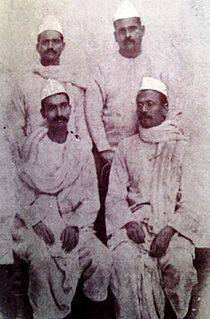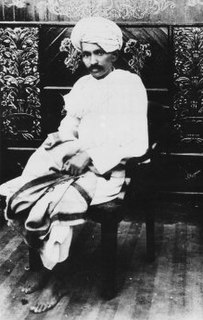 W
WGandhism is a body of ideas that describes the inspiration, vision, and the life work of Mahatma Gandhi. It is particularly associated with his contributions to the idea of nonviolent resistance, sometimes also called civil resistance. The two pillars of Gandhism are truth and nonviolence.
 W
WThe Bardoli Satyagraha, in the state of Gujarat, India during the British Raj, was a major episode of civil disobedience and revolt in the Indian Independence Movement on 12 June 1928. The movement was eventually led by Vallabhbhai Patel, and its success gave rise to Patel becoming one of the main leaders of the independence movement.
 W
WThe Champaran Satyagraha of 1917 was the first satyagraha movement led by Mahatma Gandhi in India and is considered a historically important rebellion in the Indian freedom struggle. It was a farmer's uprising that took place in Champaran district of Bihar in India, during the British colonial period. The farmers were protesting against having to grow indigo with barely any payment for it.
 W
WComposite nationalism is a concept that argues that the Indian nation is made of up people of diverse cultures, castes, communities, and faiths. The idea teaches that "nationalism cannot be defined by religion in India." While Indian citizens maintain their distinctive religious traditions, they are members of one united Indian nation. Composite nationalism maintains that prior to the arrival of the British to the Indian subcontinent, no enmity between people of different religious faiths existed; and as such these artificial divisions can be overcome by Indian society.
 W
WThe Death and Afterlife of Mahatma Gandhi is a 2014 non-fiction book by Indian writer Makarand Paranjape and published by Penguin Random House. The book is based on the analysis of Assassination of Mahatma Gandhi and the situations after his assassination.
 W
WThe Gandhi Bhawan is a major landmark of the city of Chandigarh, India, and a center dedicated to the study of the words and works of Mohandas K. Gandhi. It was designed by the architect Pierre Jeanneret, a cousin of Le Corbusier.
 W
WHindu–Muslim unity is a religiopolitical concept in the Indian subcontinent which stresses members of the two largest faith groups there, Hindus and Muslims working together for the common good. The concept was championed by various person such as leaders in the Indian independence movement, such as Mahatma Gandhi and Khan Abdul Ghaffar Khan, as well as by political parties and movements, such as the Indian National Congress, Khudai Khidmatgar and All India Azad Muslim Conference. Those who opposed the partition of colonial India often adhered to the doctrine of composite nationalism.
 W
WJamnalal Bajaj Award is an Indian award, for promoting Gandhian values, community service and social development. Established in 1978, by the Jamnalal Bajaj Foundation of Bajaj Group, it is given annually in four categories, and usually presented by the President, Vice president, Prime Minister of India or a leading figure. The foundation currently headed by Rahul Bajaj, was created in 1977, in the memory of group founder, philanthropist and a close associate of Mahatma Gandhi, Jamnalal Bajaj. The award ceremony takes place on his birth anniversary, November 4.
 W
WThe Kheda Satyagraha of 1918 was a satyagraha movement in the Kheda district of Gujarat in India organised by Mahatma Gandhi during the period of the British Raj. It was a major revolt in the Indian independence movement. It was the second Satyagraha movement, after Champaran Satyagraha. Gandhi organised the movement to support peasants.
 W
WBasic Education is a principle which states that knowledge and work are not separate. Mahatma Gandhi promoted an educational curriculum with the same name based on this pedagogical principle.
 W
WThe Quit India speech is a speech made by Mahatma Gandhi on 8 August 1942, on the eve of the Quit India movement. He called for determined, but passive resistance that signified the certitude that Gandhi foresaw for the movement, best described by his call to Do or Die. His speech was issued at the Gowalia Tank Maidan park in Bombay, since renamed August Kranti Maidan. However, almost the entire Congress leadership, and not merely at the national level, was put into confinement less than twenty-four hours after Gandhi's speech, and the greater number of the Congress leaders were to spend the rest of the war in jail. Gandhi made this speech to help India gain independence.
 W
WRam Narayan Chaudhary was a Gandhian social reformer, anti-colonial nationalist, writer, and publisher, from Rajasthan in India who contributed over three decades of his life to the Indian independence movement.
 W
WThe Salt March, also known as the Salt Satyagraha, Dandi March and the Dandi Satyagraha, was an act of nonviolent civil disobedience in colonial India led by Mahatma Gandhi. The twenty-four day march lasted from 12 March 1930 to 5 April 1930 as a direct action campaign of tax resistance and nonviolent protest against the British salt monopoly. Another reason for this march was that the Civil Disobedience Movement needed a strong inauguration that would inspire more people to follow Gandhi's example. Gandhi started this march with 78 of his trusted volunteers. The march spanned 240 miles (390 km), from Sabarmati Ashram to Dandi, which was called Navsari at that time. Growing numbers of Indians joined them along the way. When Gandhi broke the British Raj salt laws at 8:30 am on 6 April 1930, it sparked large scale acts of civil disobedience against the salt laws by millions of Indians.
 W
WSatyagraha, or "holding firmly to truth", or "truth force", is a particular form of nonviolent resistance or civil resistance. Someone who practises satyagraha is a satyagrahi.
 W
WThe Swadeshi movement was part of the Indian independence movement and contributed to the development of Indian nationalism.After the British Government's decision for the partition of Bengal was made public in December 1903, there was a lot of growing discontentment among the Indians.In response the Swadeshi movement was formally started from Town Hall Calcutta on 7 August 1905 to curb foreign goods by relying on domestic production. Mahatma Gandhi described it as the soul of swaraj (self-rule). The movement took its vast size and shape after rich Indians donated money and land dedicated to Khadi and Gramodyog societies which started cloth production in every household. It also included other village industries so as to make village self sufficient and self reliant. Indian National Congress used this movement as arsenal for freedom struggle and ultimately on 15 August 1947, a hand spun Khadi 'tricolor ashok chakra' Indian flag was unfurled at 'Princess Park' near India Gate, New Delhi by Pandit Nehru.
 W
WSwarāj can mean generally self-governance or "self-rule", and was used synonymously with "home-rule" by Maharishi Dayanand Saraswati and later on by Mahatma Gandhi, but the word usually refers to Gandhi's concept of Indian independence from foreign domination. Swaraj lays stress on governance, not by a hierarchical government, but by self-governance through individuals and community building. The focus is on political decentralisation. Since this is against the political and social systems followed by Britain, Gandhi's concept of Swaraj advocated India's discarding British political, economic, bureaucratic, legal, military, and educational institutions. S. Satyamurti, Chittaranjan Das and Motilal Nehru were among a contrasting group of Swarajists who laid the foundation for parliamentary democracy in India.
 W
WRayyan
 W
WThe three wise monkeys are a Japanese pictorial maxim, embodying the proverbial principle "see no evil, hear no evil, speak no evil". The three monkeys areMizaru, who sees no evil, covering its eyes Kikazaru, who hears no evil, covering its ears, and Iwazaru, who speaks no evil, covering its mouth.